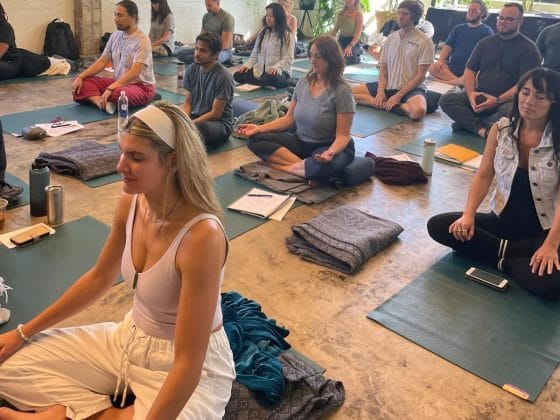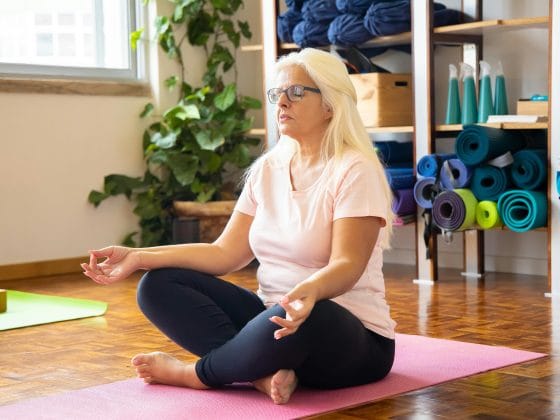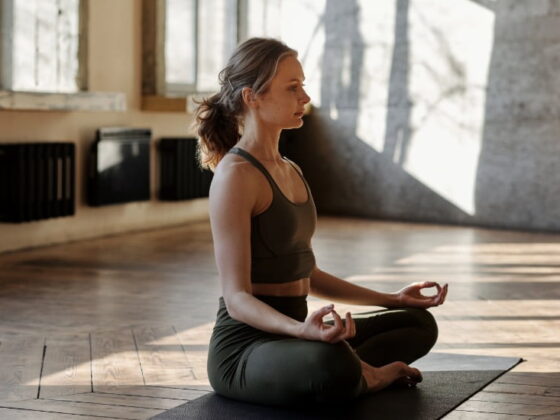Meditation is a powerful tool for both physical and mental health. The practice of calming the mind and body can help reduce stress, improve focus, and promote relaxation.
For those who want to start meditating but don’t know where to begin, learning how to meditate on your own at home is a great way to start. This guide will provide everything you need to get started with meditation in the comfort of your own home.
Whether you’re a complete beginner or have some experience with meditation, this guide will walk you through each step of the process. You’ll learn how to create a comfortable space for yourself, find the right posture for your body, choose a mantra or guided meditation that works for you, and use breathing techniques to deepen your practice.
With a bit of commitment and patience, anyone can learn how to meditate online on their own at home!
Benefits Of Meditation
Meditation offers a wide range of physical and mental benefits. When done regularly, it can reduce stress levels, improve concentration and clarity of mind, increase feelings of contentment and joy, reduce anxiety and depression, enhance creativity and intuition, lower blood pressure, reduce inflammation in the body, and much more.
In addition to these tangible physical and mental benefits, regular meditation can help one gain greater insight into their inner self by cultivating self-awareness and emotional intelligence.
As you can see, there are many reasons why dedicating space and time for your own practice is so beneficial.
Daily Mindful Habits
Practicing a few minutes of mindfulness every day can help you become more aware of how you respond to stress, and also make it easier to stay in the present moment.
You can start by taking a few moments each day to observe your thoughts without judging them, setting aside some time for mindful breathing, or even just taking a few minutes to appreciate the beauty in the world around you.
As you practice these mindful habits, they will become an integral part of your life and will help create lasting change.

So, How to Start?
Establishing a routine can be challenging, but once you’ve got it down, it’s easy to stick with it. Staying motivated can also be difficult, but if you keep reminding yourself why you’re doing this, it’ll be much easier.
1. Establishing A Routine
Creating a consistent routine is key when it comes to making meditation a part of your daily life. Start by deciding what time of day you’d like to meditate, and then make sure you set aside that same amount of time each day.
It doesn’t have to be an hour – even 10 or 15 minutes can help you create a habit.
Also, consistency is more important than the length of the meditation; if you try to meditate for 3 hours one day, but then never do it again, it won’t become a habit.
So make sure you stick with whatever amount of time works best for you!
2. Scheduling
Finding the right time to meditate is key for getting the most out of your practice. It doesn’t have to be long – even a few minutes a day can make a difference.
Consider what works best for you and your lifestyle: if you’re an early riser, then mornings might be the best; if you’re a night owl, evenings might work better. However, it’s also important to find balance and not overextend yourself – so don’t feel like you have to meditate every single day if that isn’t working out for you.
Whatever time works best for your schedule, it helps to set reminders and stick with it as much as possible. With regular practice, meditation can become part of your daily routine and ultimately improve your wellbeing.
3. Staying Motivated
Once you have a routine established, it’s important to stay motivated and stick with it. It can be easy to lose interest or forget about your daily practice, especially if you experience obstacles along the way.
To keep going, remember why it is important to you. Remind yourself of the benefits of meditating and how you want to feel by doing it.
You could also try experimenting with different types of meditation or set small goals for yourself to help stay motivated.
Finally, don’t be too hard on yourself if you miss a day – just pick up where you left off and resume your routine!
4. Use Youtube For Guided Videos
One great way is to look for guided videos on YouTube. Guided videos are an effective way to learn meditation basics as they provide a step-by-step instruction with an experienced guide.
With the help of these videos, you can begin your journey toward learning one of the most powerful tools available for relaxation and self-care. Plus, they’re usually free and accessible anytime you need them!
5. Apps For Guided Meditation
Guided meditation apps can be especially helpful for beginners since they offer structure and provide directions on how to get into the practice.
You can find apps that feature soothing sounds, images, and verbal instruction. With the right app, you’ll be able to explore different types of meditation and find what works best for you—all while enjoying being able to meditate in the comfort of your own home.
Getting Started: Types Of Meditation
All you need is a quiet space that’s free from distractions, comfortable clothes, and an open mind. Once you have all of these elements in place, you can start to explore different types of meditation and discover which works best for you.
After some practice you’ll be able to settle into a regular routine that suits your style.
There are many forms of meditation available to practice, ranging from simple relaxation techniques to more complex spiritual practices.
It’s important to choose the type that best suits your needs and preferences.
Some popular options include mindfulness meditation, guided meditation, mantra meditation, visualization, loving-kindness meditation, body scan and transcendental meditation.
Each type has its own unique benefits and goals.
Experiment with different approaches until you find one that works best for you. Lets take a look at some of the main ones.

1. Mindfulness
To start practising mindfulness, simply become aware of your breath and the physical sensations that accompany it as you inhale and exhale.
Then move on to noticing the sounds around you, the feeling of your body in space, and the movement of thoughts through your mind.
With practise, you’ll be able to stay focused on one sensation or thought for longer periods of time.
It can also help you become more aware of how certain activities make you feel, enabling you to identify patterns that can be addressed with meditation or lifestyle changes.
Start small and build up as your confidence grows – soon enough, mindfulness will become a part of your daily routine!
Through practice, we can learn to observe our thoughts without judgment, enabling us to gain insight into our own behavior and motivations.
By applying this newfound knowledge to our lives, we can make informed decisions that lead to more fulfilled lives.
2. Breathwork In Meditation
Breathwork involves focusing on each inhale and exhale, allowing your body to relax into a state of mindful awareness.
With practice, you can learn how to control your breathing and use it as a means of calming yourself in moments of stress or anxiety.
As you deepen your breathwork practice, you’ll start to notice changes in your physical and emotional states, leading to a greater sense of peace and well-being.
Ultimately, breathwork is an invaluable part of any meditation practice, allowing us to tap into our inner strength and resilience.
3. Guided Meditation And Body Scan Exercises
The great thing about learning meditation on your own is that you can tailor your practice to suit what works for you.
Guided meditation and body scan exercises are two popular practices that are beneficial for beginners, as they provide structure and support.
Guided meditations involve listening to a voice or music and following along with the instructions. Body scan exercises involve focusing on different parts of your body, one at a time, while taking notice of any sensations or feelings.
Both of these practices can be done either sitting or lying down and can help to cultivate awareness, relaxation, and mental clarity.
So give them a try to find out which one works best for you!
4. Visualization And Affirmations
Visualization and affirmations are two effective techniques for meditation. Visualizing is a great way to quiet your mind, as it helps to focus on positive images and feelings rather than worrying about the future or ruminating on the past.
Affirmations are powerful statements that help you affirm what you want in life and remind yourself of your goals. They also provide a calming effect, as they can serve as a reminder to be kinder and more compassionate toward yourself.
With regular practice, these techniques can help you deepen your meditative practice and gain greater insight into who you are.
5. Music-Assisted Meditations
Music-assisted meditations can be an enjoyable way to practice meditation on your own at home. Listening to calming music while focusing on your breath or a mantra can help you quiet the mind and relax into a meditative state.
You don’t need any special music, but if you want to take it up a notch, some guided meditations provide music specifically designed to enhance the experience. You could also look for tracks that feature multiple layers of instruments and voices, or even binaural beats, which use sound frequencies to create effects in the brain.
Whichever type of music you choose, make sure it’s something that helps you stay focused and relaxed during your meditation session.
6. Mantras, Chanting, And Sound-Based Meditations
Moving on from music-assisted meditations, mantras, chanting, and sound-based meditations are another type of meditation to try.
These kinds of meditations offer a unique opportunity to use sound as the primary focus for your meditation practice.
They can be an effective way to clear your mind and relax your body.
You can use anything from a single word or phrase to longer chants and mantras, all while focusing on the vibration of the sound that you’re making.
Allowing yourself to get lost in the rhythm of the chant or mantra can really help you reach a more peaceful internal state.
Additionally, some people find that using this kind of meditation helps them connect with their spiritual side.
So why not give it a try?

7. Visualization Techniques
Visualizing a peaceful or calming scene can help you clear your mind and stay in the moment. As you practice, try to visualize different things such as a beach, a mountain peak, or other calming images.
It’s important to use vivid detail when visualizing- really think about how it looks, smells, and feels.
You can also use visualization techniques to focus on specific goals or intentions for your meditation session.
Imagine what it would look like if you achieved your desired outcome – this can be a powerful way to manifest your desires and set yourself up for success!
8. Utilizing Apps For Practice
Visualization techniques are a great way to relax and focus, but they can be difficult to learn without guidance. Fortunately, there are apps available that provide guided meditations and other helpful resources to make learning meditation easier.
With the right app, you can find what works for you and practice whenever it’s convenient. That said, it’s important to remember that apps can’t fully replace an experienced meditation teacher or mentor, so it’s best to use them as a supplement to your own practice.
Moving Beyond
As you become more comfortable with meditation, you may find that it’s time to move beyond sitting meditations.
Taking the practice into your own hands beyond the cushion can be a liberating experience; no longer will you be bound by a specific time and place. Meditation can be practiced anywhere, anytime. While you might feel that you need formal sittings, all you really need is a moment to re connect.
Though you can’t stop all thoughts from entering your mind, you can observe them without judgement or attachment and let them pass by. You don’t have to fight against thoughts, just acknowledge them and move on.
The more you practice, the easier it will becomes to where thoughts will be just like clouds in the sky.

Dealing With Challenges
Meditation is a practice that can be challenging at times. It’s normal to feel distracted, frustrated, or overwhelmed while learning to meditate.
To help you stay focused and motivated, it’s important to have strategies in place for dealing with these challenges. Regularly reassessing your goals and practices can help you stay on track, as well as finding a helpful support system from friends or professionals if needed.
Taking breaks when necessary will also allow you to come back to meditation with more energy and enthusiasm.
Finding Guidance
If you are looking for more guidance or would like to join a local community of meditators, then consider signing up for a meditation class or joining a meditation group.
You can find classes and groups at yoga studios, healing centers, or even online. In some cases, the classes may require fees but there may also be free options available.
Joining a class or group provides an opportunity to ask questions and get personalized advice from experienced meditators which can help you develop your practice further.
Moreover, the collective energy of the class or group can be supportive and inspiring – so don’t hesitate to take advantage of this opportunity if it is available to you.
Finding Inspiration
Sometimes it can be difficult to motivate ourselves to practice meditation regularly. Fortunately, there are plenty of ways to find inspiration and stay motivated.
Doing a bit of research on the history and benefits of meditation can help provide some context and encourage you to stick to your practice.
You could also look for guided meditations online, in books, audio recordings or take an online meditation training.
Listening to inspiring stories from can give you something to aspire towards and remind you why it’s important to keep going.
If you’re ever feeling unmotivated or overwhelmed, take a break from your practice, then come back with a fresh outlook when ready.
Remember, this is an opportunity for self-care as well as personal growth, so focus on what works best for you.
The Takeaway
Meditation starts as a practice and becomes a way of life and it all starts with a single step.



